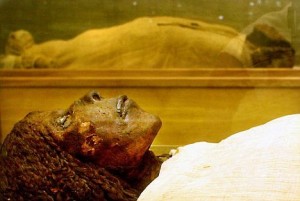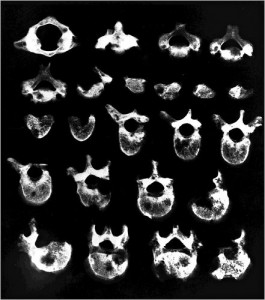Cancer research is a hot topic in today’s medical community. Many of society’s best and brightest work tirelessly to eradicate cancer from world, developing new drugs, surgical techniques, and prevention methods. Curing cancer, however, is largely contingent on pinpointing its causes. This is where archaeology plays a role. Is cancer strictly a result of modern lifestyle, or was it present in ancient times? If it was, what were the rates at which cancer was contracted in different areas over different periods of time? Is there any overlap between the causes of cancer in the modern world and in the past? These are all questions archaeologists can answer.
Two colleagues at Manchester University, Rosalie David and Michael Zimmerman, have done extensive research on cancer in the past. They have searched for references to the disease in classical literature, looked for evidence in the fossil record and in mummified bodies, and even gathered data about other pathologies contracted in ancient times to establish a frame of reference with respect to modern times.[3] Their findings: cancer is man-made. In the journal Nature Reviews: Cancer, the two archaeologists reported a “striking rarity of malignancies in ancient physical remains” that might “indicate that cancer was rare in antiquity”[1][2]. Said Professor David, “There is nothing in the natural environment that can cause cancer. So it has to be a man-made disease, down to pollution and changes to our diet and lifestyle”[3].
Many disagree with the above viewpoint. According to Cancer researcher Dr. Robert A. Weinberg, “There is no reason to think cancer is a new disease. In former times, it was less common because people were struck down midlife by other things.” Furthermore, the scarcity of evidence for cancer in David and Zimmerman’s research can be accounted for by a number of factors.

Mummified remains often retain soft tissue, and are promising prospects for evidence of ancient cancer
Cancer generally develops in soft tissue, which tends to disappear before archaeologists can find it. Additionally, there are large gaps in archaeological records. For a long time, archaeologists only collected skulls. There is no telling what sort of cancer evidence was present in discarded skeletons[1]. Recent findings, such as a 4,200-Year-Old case of breast cancer [4] and a skeleton with cancer from 3000 years ago,[5] suggest even further that cancer is not a modern phenomenon.

Figure 2 An X-ray of an early medieval man exhibiting signs of metastatic carcinoma–a cancer that begins in soft tissue but then spreads to bones
So is cancer a disease brought about by modern lifestyle choices? It appears as if the answer is both yes and no. As research continues to be done, it appears as if cancer was less prevalent in ancient times. While modernity has increased the incidence of cancer, it cannot be blamed entirely; says Dr. Weinberg, “Cancer is an inevitability once you create complex multicellular organisms and give the individual cells license to proliferate. If we lived long enough, sooner or later we would all get cancer.”[1] It appears as if archaeology has provided us with the following conclusion: cancer is not strictly a result of modern living, but there are still common lifestyle changes that need to be made in order to reduce its presence.
References
1http://www.nytimes.com/2010/12/28/health/28cancer.html
2http://www.nature.com/nrc/journal/v10/n10/abs/nrc2914.html
4http://www.archaeology.org/news/3114-150325-egypt-breast-cancer
5http://www.sciencedaily.com/releases/2014/03/140318112207.htm
Further Reading
http://www.cancer.org/cancer/cancerbasics/thehistoryofcancer/the-history-of-cancer-what-is-cancer
http://scienceblogs.com/insolence/2015/03/31/ancient-cancer/

Discovering and interpreting the presence of ancient illnesses in populations is just one of the many uses of archaeology. I found David and Zimmerman’s findings about the origins of cancer to be intriguing. Although cancer is not man-made, using archaeological techniques, we can theorize and attempt to understand how individuals lived while suffering from the disease. This could provide insight into cultural practices such as healing and medicine. One of the roles of archaeology is to constantly find connections between the past and the present. A possible archaeological study of an ancient society that dealt with cancer could provide answers for contemporary medical professionals who are still searching for a cure.
Archaeologists have been studying other diseases too, including those that seem to have started in domestic cows, pigs, and chickens before infecting humans. The domestication of animals changed the genetic makeup of species and gave pathogens new trajectories. Understanding that past may help us prevent similar disease trajectories from developing in the future.
In doing this post, I researched the archaeology of other diseases as well. I encountered an article in Popular Mechanics that covers the archaeology of HIV/AIDS, primarily its origin as a simian virus that mutated and began infecting humans. The virus’s origin was traced to Kinshasa, a city-province in what is now the Democratic Republic of Congo, in the early 1920’s. The archaeology of HIV/AIDS is critically important; the virus has already killed tens of millions worldwide, so obtaining information on how it mutates and spreads is key in preventing it from doing so in the future.
Sources:
http://www.popularmechanics.com/science/health/a11361/how-tech-traced-hiv-to-its-beginnings-17270225/
http://www.sciencemag.org/content/346/6205/56